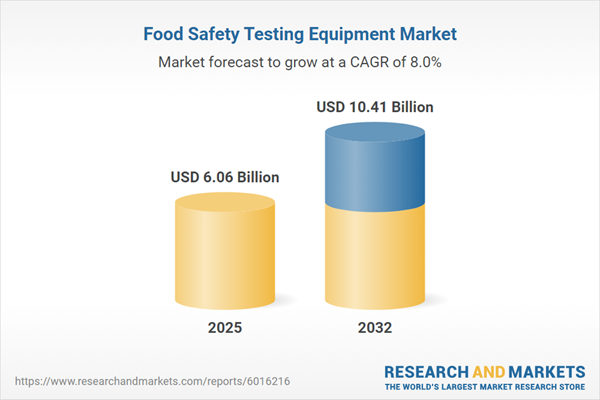Speak directly to the analyst to clarify any post sales queries you may have.
The food safety testing equipment market is seeing considerable transformation, driven by globalization, stricter regulations, and rapid technological advancements. Decision-makers now face heightened requirements for product integrity, operational resilience, and streamlined compliance within increasingly complex supply chains.
Market Snapshot: Food Safety Testing Equipment Market Growth and Outlook
The food safety testing equipment market grew from USD 5.64 billion in 2024 to USD 6.06 billion in 2025. With an expected CAGR of 7.95%, it is projected to reach USD 10.41 billion by 2032. This robust trajectory reflects surging demand for advanced detection and analytical tools across laboratories, manufacturers, and regulatory agencies worldwide. These investments are propelled by escalating consumer expectations for food quality, greater supply chain complexity, and ongoing regulatory evolution in both mature and emerging economies.
Scope & Segmentation of the Food Safety Testing Equipment Market
- Product Types: Instruments (including autoclaves, chromatography equipment, dioxin analyzers, incubators, microscopes, moisture analyzers, PCR machines, refractometers, spectrophotometers), kits, reagents, and consumables
- Testing Types: Allergen testing (gluten, lactose, peanut, tree nut), chemical testing (contaminant and pesticide residue), and microbiology testing (pathogen and spoilage organism detection)
- Food Contaminant Types: Biological, chemical, and physical contaminants
- Applications: Final product, in-process, raw material, and shelf-life testing
- End-User Industries: Bakery and confectionery, beverages, dairy, fruits and vegetables, meat/poultry/seafood, processed foods, and snacks
- Regions Covered: Americas (with focused coverage of North America: United States, Canada, Mexico; and Latin America: Brazil, Argentina, Chile, Colombia, Peru); Europe, Middle East & Africa (including United Kingdom, Germany, France, Russia, Italy, Spain, Netherlands, Sweden, Poland, Switzerland, United Arab Emirates, Saudi Arabia, Qatar, Turkey, Israel, South Africa, Nigeria, Egypt, Kenya); Asia-Pacific (China, India, Japan, Australia, South Korea, Indonesia, Thailand, Malaysia, Singapore, Taiwan)
- Company Coverage: Thermo Fisher Scientific, Agilent Technologies, 3M, Bio-Rad Laboratories, BioFront Technologies, bioMérieux, Bruker, Charm Sciences, Danaher, Ecolab, EnviroLogix, FOSS, Hitachi, Horiba, Hygiena, Japan Instrumentation System, LaMotte, Merck, MP Biomedicals, Oxford Nanopore Technologies, PerkinElmer, QIAGEN, R-Biopharm AG, Randox Laboratories, Romer Labs, SAFETRACES, Shimadzu, Teledyne, Waters Corporation
Key Takeaways for Senior Decision-Makers
- Advanced platforms enable real-time hazard detection, with data analytics and automation supporting swift risk mitigation and compliance reporting across the supply chain.
- Integrating Internet of Things connectivity and cloud-based management systems improves laboratory efficiency, allowing predictive maintenance and enhanced traceability.
- Product and testing diversification, such as allergen screening and contaminant monitoring, support industries as they respond to evolving consumer health trends and stricter allowable thresholds.
- Regional drivers shift procurement and adoption strategies—a focus on high-throughput solutions dominates North America, while cost-effective kits appeal in Latin America and Africa prioritizes portable devices for broader testing access.
- Strategic partnerships and acquisitions foster innovation, expanding offerings and market reach, as industry leaders integrate digital analytics with instrumentation for end-to-end solutions.
- Provider differentiation is increasingly based on analysis speed, platform adaptability, and the robustness of technical support networks that maximize uptime and client satisfaction.
Tariff Impact on Equipment Costs and Supply Chains
The introduction of United States tariffs in 2025 has accelerated shifts in sourcing and manufacturing strategies throughout the sector. Successful organizations adapt by renegotiating supplier contracts, prioritizing domestic partnerships, and exploring alternative reagents—all while carefully balancing costs against operational needs and technology access. Accelerated regulatory approvals for local producers are under consideration to further mitigate supply disruptions.
Methodology & Data Sources
This report relies on a blend of primary interviews with laboratory directors, regulatory officials, and industry leaders, complemented by secondary analysis of proprietary databases and published research. Quantitative modeling and cross-segmentation were applied to ensure comprehensive, validated insights.
Why This Report Matters
- Pinpoints actionable strategies to help organizations strengthen regulatory compliance, brand reputation, and operational efficiency in a fast-moving global environment.
- Clarifies post-2025 supply chain risks and procurement trends, empowering leaders to adjust technology and investment roadmaps with confidence.
- Delivers authoritative, segment-specific intelligence for manufacturers, service providers, and investors responding to technological and regulatory disruptions.
Conclusion
The future of the food safety testing equipment market hinges on the deployment of advanced, adaptive platforms attuned to evolving regulatory demands and global trade dynamics. This report equips stakeholders with the clarity and insight needed to drive growth, resilience, and best-practice assurance in the sector.
Additional Product Information:
- Purchase of this report includes 1 year online access with quarterly updates.
- This report can be updated on request. Please contact our Customer Experience team using the Ask a Question widget on our website.
Table of Contents
3. Executive Summary
4. Market Overview
7. Cumulative Impact of Artificial Intelligence 2025
Companies Mentioned
The companies profiled in this Food Safety Testing Equipment market report include:- Thermo Fisher Scientific Inc.
- Agilent Technologies, Inc.
- 3M Company
- Bio-Rad Laboratories, Inc.
- BioFront Technologies
- bioMérieux SA
- Bruker Corporation
- Charm Sciences, Inc.
- Danaher Corporation
- Ecolab Inc.
- EnviroLogix Inc.
- FOSS A/S
- Hitachi, Ltd.
- Horiba, Ltd.
- Hygiena LLC
- Japan Instrumentation System Co., Ltd.
- LaMotte Company
- Merck KGaA
- MP Biomedicals, LLC by Valiant Co., Ltd.
- Oxford Nanopore Technologies Ltd
- PerkinElmer Inc.
- QIAGEN N.V.
- R-Biopharm AG
- Randox Laboratories
- Romer Labs Inc. by Koninklijke DSM N.V.
- SAFETRACES, Inc.
- Shimadzu Corporation
- Teledyne Technologies Incorporated
- Waters Corporation
Table Information
| Report Attribute | Details |
|---|---|
| No. of Pages | 180 |
| Published | October 2025 |
| Forecast Period | 2025 - 2032 |
| Estimated Market Value ( USD | $ 6.06 Billion |
| Forecasted Market Value ( USD | $ 10.41 Billion |
| Compound Annual Growth Rate | 7.9% |
| Regions Covered | Global |
| No. of Companies Mentioned | 30 |









